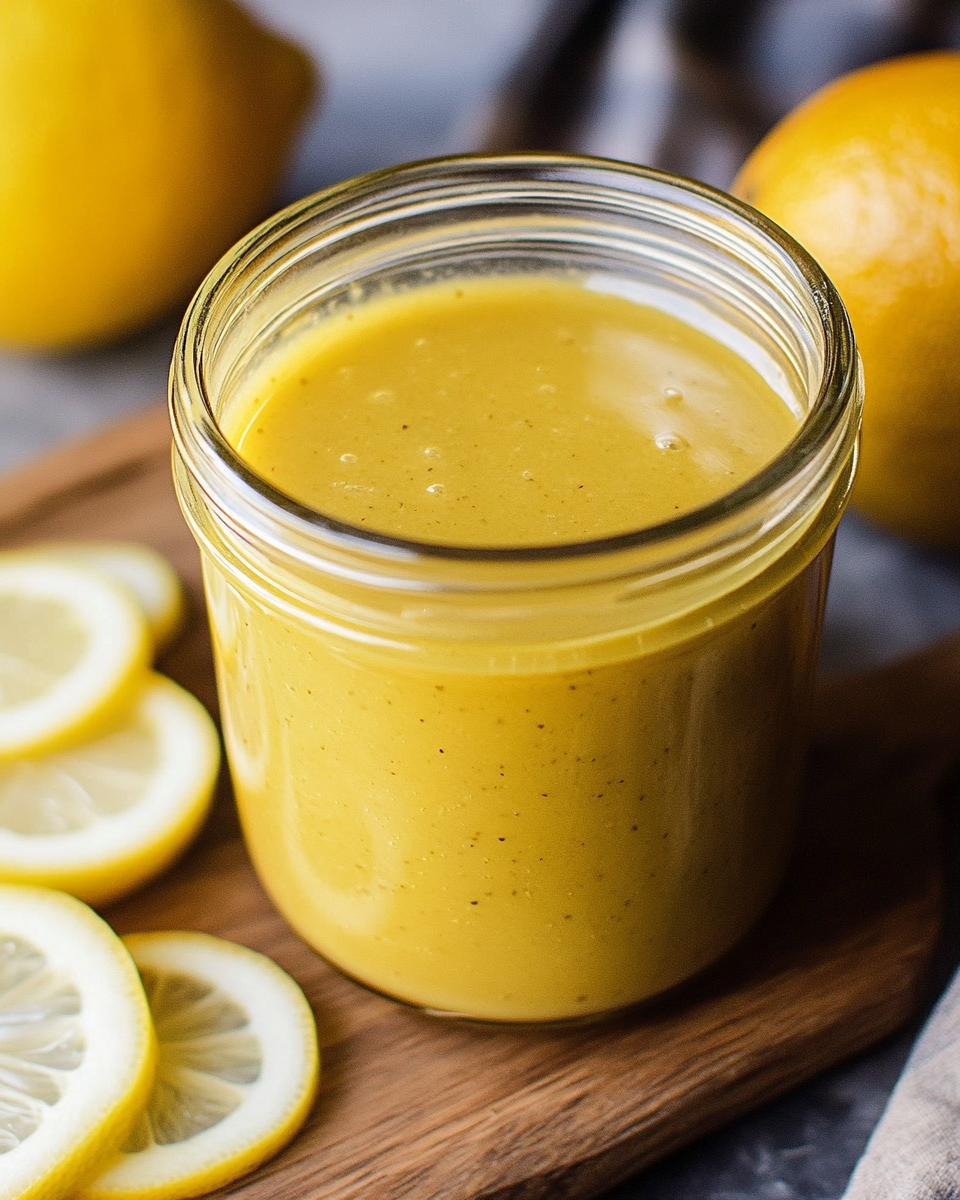This honey lemon vinaigrette is a game-changer for salads and beyond. Light, tangy, and gently sweetened with honey, it’s a refreshing dressing that instantly elevates even the simplest dish. It strikes the perfect balance between acidity from fresh lemon juice and apple cider vinegar, richness from olive oil, and a subtle sweetness from honey. With the bold kick of Dijon mustard and a hint of garlic, it’s versatile enough to use as a salad dressing, marinade, or flavor enhancer for roasted vegetables.

The best part? It’s made with pantry staples and takes less than 10 minutes to prepare. Whether you’re meal prepping or looking for a quick way to dress your greens, this vinaigrette is the answer.
Why You’ll Love This Recipe
- Made with simple, clean ingredients you likely already have.
- Ready in minutes—perfect for weeknights or last-minute meals.
- Adaptable flavor—make it sweeter or more tangy to your preference.
- Works great as a salad dressing or marinade.
- No preservatives, stabilizers, or additives—just real food.
Preparation Phase and Tools to Use
To ensure a smooth and flavorful vinaigrette, proper preparation and tools make a big difference. Here’s what you’ll need.
Essential Tools and Equipment
- Blender or food processor: For the smoothest and most emulsified texture.
- Mason jar with tight-fitting lid: Great for shaking and storing the dressing.
- Medium mixing bowl and whisk: Ideal if you prefer to mix by hand.
- Citrus juicer: To extract fresh lemon juice easily and efficiently.
- Microplane or garlic press: For finely mincing garlic.
Importance of Each Tool
- A blender or food processor quickly combines the ingredients into a smooth, emulsified vinaigrette.
- A mason jar allows for simple shake-and-serve convenience and is perfect for storage.
- A whisk gives you manual control over emulsification.
- A juicer ensures maximum juice extraction while minimizing seeds or pulp.
- A microplane finely grates garlic, helping it blend seamlessly into the dressing.
Preparation Tips
- Use freshly squeezed lemon juice instead of bottled for the brightest flavor.
- Warm the honey slightly if mixing by hand—it blends better with other ingredients.
- Adjust the amount of honey and mustard based on your desired balance of sweetness and acidity.
- For a deeper flavor, allow the dressing to chill for 30 minutes before serving.
- Shake or whisk the vinaigrette well before each use as separation is natural.
Ingredients List
Organized for clarity, here’s what you’ll need:
Wet Ingredients:
- 4 ounces olive oil (about ½ cup)
- 2 tablespoons lemon juice (freshly squeezed)
- 2 tablespoons apple cider vinegar
- 2 tablespoons Dijon mustard
- 2 tablespoons honey (or more, to taste)
Seasonings and Aromatics:
- 2 cloves garlic, minced
- 1 teaspoon dried oregano
- ½ teaspoon kosher salt (or to taste)
- ¼ teaspoon ground black pepper
Each ingredient brings something essential. Olive oil offers richness. Lemon juice and vinegar add brightness. Mustard gives body and helps emulsify. Honey balances the acidity. Garlic and oregano bring depth and aroma. Salt and pepper enhance overall flavor.
Step-by-Step Directions
You can prepare this honey lemon vinaigrette in a few ways depending on the tools available.
Option 1: Using a Blender, Food Processor, or Jar
- Combine olive oil, lemon juice, apple cider vinegar, Dijon mustard, honey, minced garlic, dried oregano, salt, and pepper.
- Blend or process until the dressing is completely smooth and emulsified.
- If using a jar, seal tightly and shake vigorously for 30–60 seconds until smooth.
Option 2: Mixing by Hand with a Whisk
- In a mixing bowl, whisk together lemon juice, apple cider vinegar, Dijon mustard, honey, garlic, oregano, salt, and pepper.
- While whisking continuously, slowly drizzle in the olive oil. This helps the dressing emulsify and stay smooth.
- Whisk until fully combined and thickened slightly.
Final Touches
- Store in the refrigerator for 30 minutes before serving for maximum flavor.
- Stir or shake well before each use.
- Serve over your favorite greens or roasted vegetables.
This dressing is easy to customize, reliable, and always delicious. Keep it in your fridge and you’ll always have a way to add fresh flavor to any meal.
Serving Suggestions for Honey Lemon Vinaigrette
This honey lemon vinaigrette is more than just a salad dressing. Its balanced combination of acidity, sweetness, and savory depth makes it one of the most flexible condiments to keep in your kitchen. Here are some top ways to serve and enjoy it:
- Toss it with fresh greens: This dressing pairs beautifully with mixed greens, spinach, arugula, and romaine. Add thinly sliced red onions, toasted nuts, or crumbled feta for added texture and flavor.
- Drizzle over roasted vegetables: Once roasted, vegetables like carrots, sweet potatoes, or Brussels sprouts shine even brighter with a light vinaigrette finish.
- Use as a marinade: This vinaigrette works wonderfully as a marinade for chicken, tofu, or shrimp. Let the protein soak for at least 30 minutes before grilling or roasting.
- Top grain bowls or quinoa salads: Add a few spoonfuls over a warm grain bowl filled with quinoa, chickpeas, cucumbers, and fresh herbs.
- Brighten up pasta salad: Instead of a mayo-based dressing, try this vinaigrette with cold pasta, cherry tomatoes, olives, and herbs.
- Drizzle on avocado toast: A light layer on avocado toast brings a new dimension of flavor.
- Add flavor to sandwiches or wraps: Use it as a spread or drizzle inside wraps with grilled vegetables or proteins.
- Enhance fruit salads: Especially when made with berries or apples, this vinaigrette adds a sweet-tart contrast.
Its light, refreshing nature makes it a fantastic addition to meals throughout the year.
Common Mistakes to Avoid
While honey lemon vinaigrette is simple to make, small errors can impact its flavor or texture. Here are the most common mistakes and how to avoid them:
1. Using Bottled Lemon Juice
Bottled lemon juice lacks the vibrant, acidic quality of fresh lemons. Always use freshly squeezed juice for the best taste.
2. Skipping the Emulsification Process
Whether using a blender or whisking by hand, emulsifying is key to a creamy and cohesive texture. Adding the oil too quickly or not whisking continuously will cause the dressing to separate.
3. Adding Too Much Garlic
Garlic adds depth, but too much can overpower the vinaigrette. Stick to two cloves, finely minced or grated, to avoid harshness.
4. Not Tasting as You Go
Balancing sweetness and acidity is essential. Some lemons are more tart, and your honey may be stronger. Taste and adjust honey, mustard, or salt as needed.
5. Using Cold Olive Oil When Whisking
If the olive oil is too cold, it may not blend smoothly. Let it reach room temperature for better emulsification.
6. Ignoring the Role of Dijon Mustard
Dijon isn’t just for flavor—it helps bind the ingredients. Skipping it can lead to quicker separation. If needed, substitute with another emulsifier like tahini or a touch of mayo.
7. Storing in the Wrong Container
Use an airtight container or jar with a tight lid to keep the vinaigrette fresh and prevent strong refrigerator odors from altering the flavor.
8. Not Shaking Before Use
Natural separation occurs. Always shake or whisk the vinaigrette again before serving to restore its smooth consistency.
Side Dish Recommendations
To create a well-rounded meal, pair honey lemon vinaigrette with dishes that highlight its citrusy, slightly sweet profile. Here are eight side dish ideas that complement the dressing perfectly:
1. Arugula and Strawberry Salad with Feta
The peppery greens and sweet strawberries balance well with the acidity and honey in the vinaigrette. Add crumbled feta for a creamy finish.
2. Roasted Brussels Sprouts with Almond Slivers
The slight bitterness of Brussels sprouts is enhanced by the sweet and tangy notes in the dressing. Toasted almonds add crunch and nutty depth.
3. Chickpea and Cucumber Salad
Toss chickpeas, cucumbers, red onion, and parsley with the vinaigrette for a refreshing and protein-rich side.
4. Quinoa with Roasted Vegetables
Roasted zucchini, red bell pepper, and squash tossed with quinoa make an excellent base for the vinaigrette to soak into.
5. Kale and Apple Slaw
Finely shredded kale and apples hold up well under the vinaigrette’s acidity, making this a perfect prep-ahead option.
6. Caprese Salad with a Citrus Twist
Fresh mozzarella, tomatoes, and basil benefit from the citrus brightness of this dressing in place of traditional balsamic.
7. Couscous with Lemon Zest and Herbs
Light and fluffy couscous mixed with lemon zest, mint, and parsley is a natural fit for the honey lemon profile.
8. Grilled Asparagus with Parmesan
Finish grilled asparagus with a drizzle of vinaigrette and shaved Parmesan for a simple but elegant side.
Each of these sides benefits from the light, bright characteristics of honey lemon vinaigrette, whether it’s adding acidity to balance fat or enhancing natural sweetness.
Recipe Tips and Flavor Variations
Mastering a great honey lemon vinaigrette means knowing how to make it your own. While the base recipe is already balanced, you can easily adjust it to fit your preferences or dietary needs.
Tips for Perfect Results
- Use quality olive oil: Since this dressing isn’t cooked, the flavor of your oil matters. Use a fruity, mild extra virgin olive oil for the best taste.
- Warm honey slightly: If your honey is too thick, a few seconds in the microwave will help it blend more easily, especially if you’re whisking by hand.
- Adjust the balance: If the dressing is too tangy, add a bit more honey. If it’s too sweet, increase the lemon juice or vinegar slightly.
- Let it rest before serving: Allow the dressing to chill in the refrigerator for about 30 minutes. This lets the flavors meld and deepen.
- Shake before each use: Natural separation is normal in vinaigrettes. A quick shake or stir will restore the texture.
Flavor Variations
Change the character of this vinaigrette with simple tweaks:
- Add fresh herbs: Mix in chopped parsley, basil, dill, or thyme for an herbed vinaigrette.
- Include citrus zest: A bit of lemon or orange zest adds brightness and complexity.
- Spice it up: A pinch of red pepper flakes or a dash of cayenne can give it a gentle heat.
- Make it creamy: Whisk in a tablespoon of Greek yogurt or tahini for a thicker, creamier version.
- Swap the vinegar: Try white wine vinegar or red wine vinegar in place of apple cider vinegar for a different acidity profile.
- Use maple syrup: Replace honey with pure maple syrup for a vegan-friendly twist and slightly earthier sweetness.
Storage and Reheating Instructions
Proper storage ensures your honey lemon vinaigrette stays fresh and safe to consume. While vinaigrettes are typically shelf-stable due to their acidic content, refrigeration is still recommended for best quality.
How to Store
- Container: Store the vinaigrette in a glass mason jar, salad dressing bottle, or any airtight container with a tight-fitting lid.
- Refrigeration: Always refrigerate the vinaigrette. It will keep for up to 7 days.
- Label and date: Mark the container with the date you made it to keep track of freshness.
What to Expect
- Separation: Natural separation of oil and vinegar will occur. Shake or whisk before serving to recombine.
- Texture: The dressing may thicken slightly in the refrigerator, especially if your kitchen is cold or the honey solidifies. Let it sit at room temperature for 10 minutes or run the sealed jar under warm water to loosen it.
Can You Freeze It?
No, this vinaigrette does not freeze well. Freezing breaks the emulsion and can lead to a gritty texture once thawed. Make only what you’ll use within a week.
Frequently Asked Questions
How long does honey lemon vinaigrette last in the fridge?
It stays fresh for up to 7 days when stored in an airtight container in the refrigerator.
Can I make it without mustard?
Yes. However, Dijon mustard helps emulsify the dressing and gives it depth. If needed, substitute with tahini or a small amount of mayonnaise.
Is this vinaigrette vegan?
Not as written, since it contains honey. To make it vegan, replace the honey with maple syrup or agave nectar.
Why does the dressing separate after refrigeration?
Separation is normal in oil-based vinaigrettes. Shake vigorously or whisk before each use. Dijon mustard and honey both help stabilize the emulsion, so don’t skip them.
Can I make a large batch?
Absolutely. You can double or triple the recipe. Store in a larger jar and use as needed throughout the week.
What type of olive oil works best?
Choose a high-quality extra virgin olive oil with a balanced flavor. A very peppery or bitter oil may overpower the vinaigrette.
Is this dressing suitable for meal prep?
Yes. It holds up well in the fridge and is great for preparing salads ahead of time. Just store the dressing separately and add it right before serving.
Conclusion
This honey lemon vinaigrette is a fresh, bright, and simple dressing that delivers both flavor and versatility. With a few ingredients and minimal prep time, you get a homemade dressing that’s miles ahead of anything store-bought. Whether you’re using it on salads, vegetables, or as a marinade, this vinaigrette will quickly become a staple in your kitchen.
Thanks to its balanced sweet-tart profile, adaptable ingredients, and clean nutrition, it works for many diets and occasions. Make a batch today and bring a burst of freshness to your next meal.
Honey Lemon Vinaigrette Salad Dressing
Ingredients
- 4 ounces olive oil about ½ cup
- 2 tablespoons lemon juice juice of 1 lemon
- 2 tablespoons apple cider vinegar
- 2 tablespoons Dijon mustard
- 2 tablespoons honey or to taste
- 2 cloves garlic minced
- 1 teaspoon dried oregano
- ½ teaspoon kosher salt or to taste
- ¼ teaspoon ground black pepper
Instructions
Using a food processor, blender, or jar:
- Combine olive oil, lemon juice, apple cider vinegar, Dijon mustard, honey, garlic, oregano, salt, and pepper.
- Blend, process, or shake vigorously until smooth and emulsified.
Using a whisk:
To serve:
- Chill the dressing in the refrigerator for about 30 minutes before serving for best flavor.
- Drizzle over your favorite salad and enjoy.




Leave a Comment